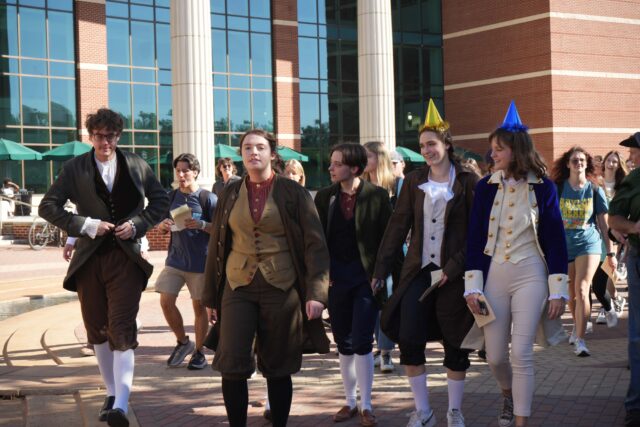By Emma Weidmann | Arts and Life Editor, Abbey Ferguson | LTVN Reporter
“A Boston Tea Party tonight!” a colonist called out, coattails and tricorn hat braving her against the wind.
Fifteen colonists gathered at the bridge, ripping into boxes full of British tea. There were more in the crowd watching from dry land, and with each box dumped, a hearty “huzzah” was raised.
No, there wasn’t a time machine built in Waco — students enrolled in Dr. Julie Sweet’s History 4340 class reenacted the Boston Tea Party at the Waco Creek Bridge on Thursday afternoon.
The real Boston Tea Party took place under cover of darkness on a cold, winter Massachusetts night in December 1773, and while the sun blazed in Waco above 80 degrees, Dr. Sweet’s history students told the tale of the seditious event as true-to-life as they could.
The tea party began at 3:30 p.m. at the Tidwell Bible Building — a stand-in for Boston’s Old South Meeting House — as a crowd gathered to hear the debate over plans for British tea that had been docked in the port for nearly a month. Sweet welcomed the crowd to the Brazos Tea Party, gave opening remarks and set the scene as the narrator of the unscripted production.
“We ask that you, the audience, use your imagination as we, both men and women, portray the men who took part in these activities,” Sweet said. “This year marks the 250th anniversary of an event that eventually became known as the Boston Tea Party… Why these men did so and the alternatives they considered is the material of our production today.”
The night of December 16, 1773 was a looming deadline, as British tea was to be unloaded from ships the next day. The consensus among the reenactors was that the tea could not be allowed to be unloaded and sold, but opinions differed widely on the solution. The Woodlands junior Micheal Ermis didn’t keep his opinion quiet as Boston merchant Lendall Pitts.
“[Massachusetts Royal] Governor Hutchinson has allowed three ships full of that pernicious weed from the East India Company to enter our harbor,” Ermis said. “It is outrageous, and it represents the very thing that has plagued the colonies for years… As a merchant, I’ve had to deal with the East India Company before, but currently, as a Son of Liberty, it’s infringing on our rights as Englishmen to be taxed on this tea [with] due representation in parliament.”
Ermis explained that some colonists wanted to burn or sink the ships, and others would’ve liked to unload the tea and destroy it on dry land. But, as one tea party participant raised, their plans were in danger of being foiled by the British, and burning the ships could burn the city down entirely.
Houston junior Sophia Tejeda stressed the need for action as craftsman Henry Purkitt.
“We have had multiple meetings in the Old South Meeting House, and Governor Hutchinson has just come back and told us that he will not support us and that British officials will seize the tea, but we are done being taxed without representation, so we have to do something about it.”

To fuel debate, Norman, Okla. senior George Schroeder engaged with the eager crowd as colonist Benjamin Edes, and he spoke directly to First Gent Brad Livingstone, who was among the crowd. Livingstone suggested that he would drink the tea instead of it being destroyed, and the colonial reenactors were incensed at the proposal.
After more discussion with the crowd, a plan was formed. Instead of burning ships or drinking the tea, the product would be dumped into the harbor in order to send a message to the British crown.
One final “Huzzah!” saw them off, and they began the half-mile trek to the Waco Creek Bridge to put the plan into action as more than 100 students, professors and families walked alongside.
While there was no tea inside the empty boxes, the reenactors stayed in character throughout the production as they mimed pillaging the British supply. When it was all over, a final cheer was raised, and Sweet closed the event.
Although Sweet previously produced a reenactment of the Boston Massacre trials, this was the first production of this scale put on by the Baylor history department, and Tejeda said it was the reason she enrolled in the class altogether.
“That’s quite cool that I get to do something like this for college credit,” Tejeda said. “It’s an experience unlike any other that you might get for credit… Everyone got really into it, so it was fun… It’s fun to do micro-history like this because you learn so much more beyond.”

Students researched their character beginning in August, each a real colonist who could have participated in the tea party. Because many participants remained anonymous to the grave, and more prominent Patriot leaders like John Adams, Samuel Adams and others weren’t present, students chose lesser-known figures to embody, according to Sweet.
“All of that involves research, but nobody said research has to be boring, and this is a perfect example of how it’s not boring,” Sweet said. “You say ‘Boston Tea Party,’ and everybody’s heard of it, everybody thinks they know the story, and the whole destruction of property… it kind of marketed itself.”
Sweet expressed her pride in her students for taking on their roles and digging deep into the research for the production.
“They’re a fabulous team,” Sweet said. “The spark is there, and the fire is lit.”






